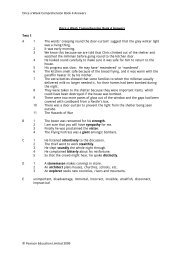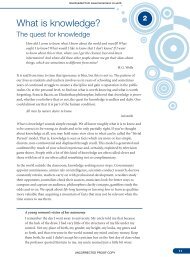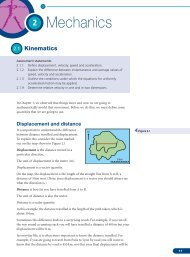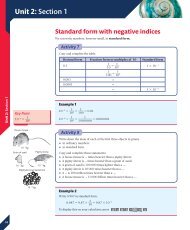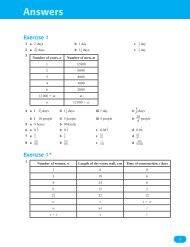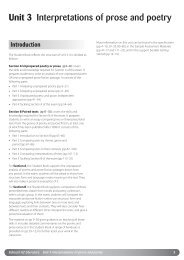Chapter 1: Hardware - Pearson Schools
Chapter 1: Hardware - Pearson Schools
Chapter 1: Hardware - Pearson Schools
Create successful ePaper yourself
Turn your PDF publications into a flip-book with our unique Google optimized e-Paper software.
Biometric scanners<br />
A biometric scanner is a pattern recognition system which makes a personal<br />
identification based on a person’s unique physical characteristics. Biometric<br />
scanners can use face recognition, fingerprint matching, iris and retinal scans,<br />
voice recognition, and hand geometry. Biometric scanners can be built into mobile<br />
phones, desktop and laptop computers, and smart cards. They can be used to<br />
control entry to buildings, and can even replace keys in cars.<br />
Advantages of biometric scanners:<br />
<br />
<br />
There is no need to remember to carry personal identification.<br />
The person has to be present. This makes identification theft and fraud much<br />
less likely.<br />
Disadvantages of biometric scanners:<br />
<br />
Identification using biometric scanners is not yet sufficiently accurate.<br />
Permitted users will not be recognised at times, and blocked users will<br />
sometimes be permitted.<br />
Sensors<br />
Sensors are used to input data about the environment into a computer. There are many<br />
types of sensors. They are available in many different shapes and sizes, and they have a<br />
wide variety of uses. For example, sensors can be used to record light intensity, temperature<br />
and pressure. Sensors usually produce a low voltage which must be converted to a digital<br />
signal for the computer using an analogue-to-digital converter (ADC).<br />
Sensors are used extensively for data logging and control applications. They are<br />
essential in applications such as the following: automatic washing machines,<br />
automatic cookers, air conditioning controllers, central heating controllers, computercontrolled<br />
greenhouses, burglar alarm systems, control of factory production lines,<br />
robotics, and for monitoring scientific experiments and remote weather stations.<br />
Figure 1.22 A biometric scanner using finger prints<br />
Connection<br />
to computer<br />
Connection<br />
to computer<br />
Plate-shaped<br />
heat sensor<br />
<strong>Chapter</strong> 1: <strong>Hardware</strong><br />
Advantages of sensors:<br />
<br />
<br />
<br />
<br />
<br />
Sensors can be placed in dangerous locations where people would be hurt.<br />
Sensors can continuously and reliably record data whereas to organise this<br />
using people could be much more unreliable and expensive.<br />
Sensors can record data that people do not sense or do not sense accurately,<br />
such as humidity.<br />
The data recorded by sensors can be automatically recorded in a form that can<br />
be processed by a computer.<br />
Data can be collected by a central computer from sensors in remote locations.<br />
People do not need to travel and this saves time and allows data to be collected<br />
more frequently.<br />
Disadvantages of sensors:<br />
<br />
<br />
Sensors cannot interpret the data.<br />
Sensors detect a very restricted range of the different types of data.<br />
Needle-shaped<br />
heat sensor<br />
Connection<br />
to computer<br />
A light sensor<br />
(photocell)<br />
Figure 1.23 Sensors are available in different<br />
shapes and sizes<br />
13









